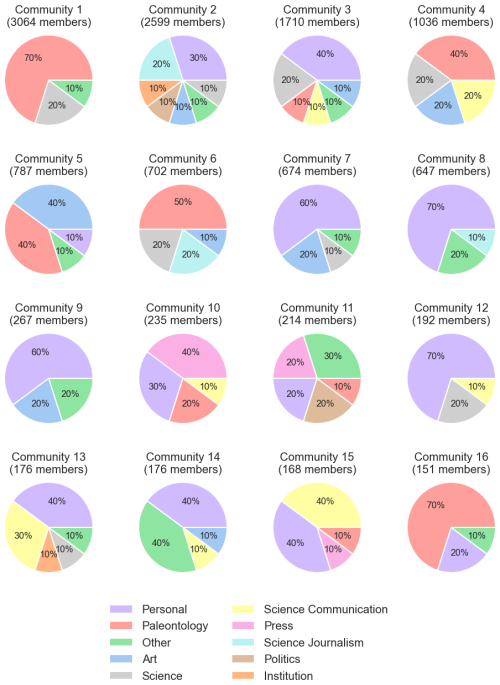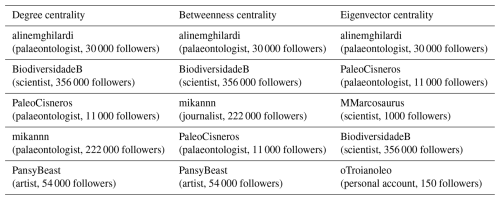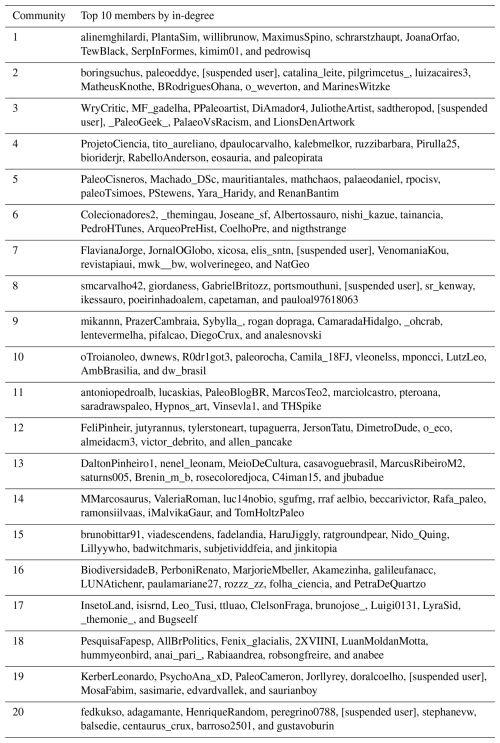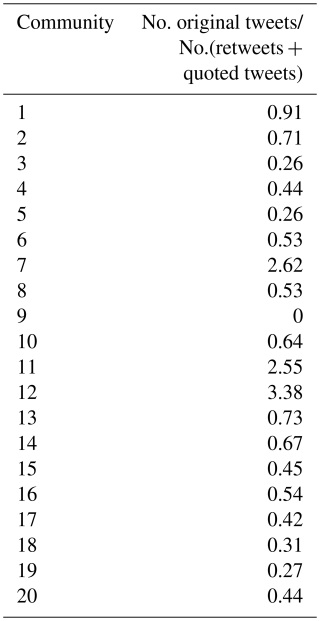the Creative Commons Attribution 4.0 License.
the Creative Commons Attribution 4.0 License.
#UbirajaraBelongstoBR: social media activism against (neo)colonial practices in palaeontology
Mohammad Ali Rahimi Fard Kashani
Nussaïbah B. Raja
Chico Q. Camargo
Social media has revolutionised the engagement between scientists and the public, offering platforms to challenge unethical practices and advocate for change. In December 2020, Brazilian palaeontologists and supporters initiated the hashtag “#UbirajaraBelongstoBR” on Twitter (now X) to protest the alleged illicit acquisition and export of the dinosaur fossil named “Ubirajara jubatus” from Brazil to Germany. This movement not only demanded the fossil's repatriation but also sparked global discussions on neocolonial practices in palaeontology.
In this study, we analyse 39 728 tweets containing the hashtag #UbirajaraBelongstoBR, collected between December 2020 and February 2023. Employing social network analysis and computational text analysis, we examine the dynamics of this online movement, identify key influencers, and assess its reach and impact. Our results reveal that the campaign transcended the palaeontology community, engaging a diverse international audience including scientists, artists, activists, and the general public. Sentiment analysis indicates shifts corresponding to pivotal events, such as official statements and the eventual repatriation of the fossil.
Our findings demonstrate the power of social media in mobilising grassroots movements and influencing scientific discourse and policy. The #UbirajaraBelongstoBR case illustrates how digital platforms can facilitate international advocacy against unethical scientific practices, highlighting social media's potential to effect change in scientific governance and promote ethical standards. This study contributes to the understanding of digital activism in science communication and underscores the evolving landscape of public engagement in scientific issues.
- Article
(5266 KB) - Full-text XML
- BibTeX
- EndNote
Social media has transformed the way in which scientists communicate their research and communication with both other scientists and non-scientists (Ocon et al., 2021; Entradas et al., 2020; Walter et al., 2019). Social media is also serving an important role in providing a platform, especially for marginalised voices in academia, who are harnessing its power to challenge existing power structures (Yammine et al., 2018). It has also been used to call out unethical practices and other issues in the academy. For example, Elisabeth Bik, who is known for posting on wrongful image manipulation in the biomedical literature, which has led to the retraction of several papers, has amassed more than 130 000 followers on Twitter (now X) (Bik, 2022; Shen, 2020).
In a similar fashion, Brazilian palaeontologists took to social media in December 2020 to raise their concerns about a newly described Brazilian dinosaur named “Ubirajara jubatus” (henceforth Ubirajara).1 Originating from the Araripe Basin, north-east of Brazil, Ubirajara has now come to represent the fight against colonial practices in modern palaeontology. The article in which Ubirajara was described raised several ethical and legal concerns over the appropriation and study of this fossil: (1) the authors and the German institution where it was reposited claimed to have obtained the fossil legally, although there did not seem to be any legal avenue for such a fossil to have found its way to Germany; (2) the authors did not seem to have involved any Brazilian institutions in the process of acquiring and researching this specimen – also against the law; (3) the region of Brazil where the fossil originated has been targeted by fossil smugglers for years; and (4) some authors in the study had been involved in controversies with irregular fossils from Brazil before (Cisneros et al., 2022a, b; Christakou, 2015; Gibney, 2014; Raja and Dunne, 2023).
On 13 December 2020, the same day that the paper describing the fossil was published, Brazilian palaeontologist Aline Ghilardi published a Twitter thread exposing the case finishing with a tweet saying “Ubirajara belongs to Brazil. #UbirajarabelongstoBR” (Ghilardi, 2020). Immediately after, the hashtag #UbirajaraBelongstoBR, protesting for the return of the fossil to Brazil, took Twitter by storm, along with other social media platforms, such as Facebook, Instagram, and YouTube, bringing together both Brazilian and non-Brazilian palaeontologists, palaeoartists, students and other members of the general public (see Fig. 1). It also fuelled discussions on colonialism in palaeontology, a topic of growing interest and importance in the discipline (e.g. Monarrez et al., 2021; Raja et al., 2022). Palaeontology as a discipline has been shaped through centuries of colonial practices, influencing not only the distribution of fossil data around the world but also the people who have access to these data (Monarrez et al., 2021; Raja et al., 2022). These practices, including the theft of fossils and exclusion of local scientists, as in the case of Ubirajara (Cisneros et al., 2022a), remain to this day and continue to deepen this bias (Raja et al., 2022). The modern materialisation of colonialism in palaeontology is especially directed at the lower- and middle-income countries, which are disproportionately underrepresented in palaeontological research and literature (Raja et al., 2022).
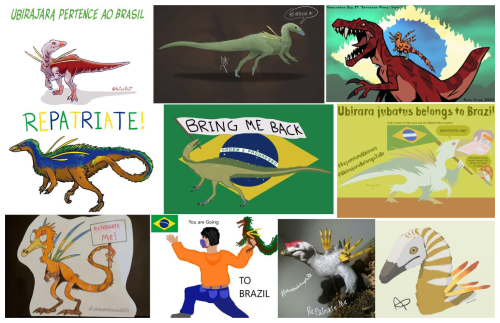
Figure 1Examples of images shared with the hashtag #UbirajarabelongstoBR by Twitter users. Image credits (from left to right and top to bottom) are as follows: @arturvict (Artur, 2020), @_themingau (Mingau, 2020), @Emily_Art (Stepp, 2020), @herbertologist (Herbert, 2020), @valent801 (Valent801, 2020), @Brenda7Kauane (Kauane, 2021), @freakyraptor (Alli, 2020), @Waxosaurus (Waxosaurus Makes, 2020), @THSpike (Paleonecromante, 2020), and @antoniopedroalb (Albuquerque, 2021).
Ubirajara is not the only Brazilian fossil studied by foreign researchers that is believed to have been illegally exported and/or acquired. Brazil, especially the Araripe Basin, has been the victim of fossil smuggling for decades, e.g. holotypes of Irritator challengeri described in 1996 and Mirischia asymmetrica in 2004 (Cisneros et al., 2022a, b). These, however, did not attracted as much attention from the public and the media as Ubirajara (e.g.), probably because they were published before the “golden age” of social media and science communication on these platforms.
In the case of Ubirajara, social media was crucial in the dissemination of information on the specimen and updates on the case. Eventually, the State Museum of Natural History Karlsruhe (SMNK) took to Instagram posting a statement that the fossil was the property of the German state of Baden-Württemberg and that it would not repatriate it in response to the backlash it was receiving, thereby attracting more criticism. The corresponding research article was permanently withdrawn soon after this, as it was found that the authors had lied and misrepresented information on how the fossil was acquired. Following an investigation, the minister of science of Baden-Württemberg recognised misconduct by SMNK and declared that the export of the fossil to Germany violated Brazilian laws and that the museum should repatriate it to Brazil, which has now happened (Black, 2022). Since the #UbirajaraBelongsToBR movement, several other Brazilian fossils, from the US and Belgium, have been repatriated (Black, 2022).
The #UbirajaraBelongsToBR case shares commonalities with other recent social movements with large online participation, such as the Black Lives Matter, #MeToo, and Occupy Wall Street movements (Jackson et al., 2020). Like these movements, it leverages the reduced coordination costs and enhanced organisational modes provided by social and digital technologies. Scholars like Earl and Kimport (2011) have highlighted how these technologies not only amplify existing forms of activism but also create fundamentally new ways of operating within social movements. They argue that digital infrastructures personalise online content, giving individuals specific reasons to protest and facilitating their ability to push for change across various platforms. This transformation has demanded a new framework of understanding, as it shifts how activists organise, communicate, and interact in efforts to achieve widespread societal impact.
Considering the similarity between the #UbirajaraBelongsToBR protest and the other movements cited above, it is natural to study them using similar approaches. For the Occupy Wall Street anticapitalist movement in the United States, for instance, the movement on Twitter appeared to draw a group of people who were already involved in local politics and other social movements abroad and who were well connected. Conover et al. (2013a, b) used a sizable sample from Twitter to track trends in Occupy Wall Street (OWS) member activity, interests, and socialisation over a period of 15 months, starting 3 months before the regime's first resistance movements. They found that users who were vocal in the early months of the movement decreased their involvement in OWS-related activity during the analysis (Conover et al., 2013a). For comparison, related studies looking at the expression of the Black Lives Matter (BLM) movement on Twitter found that BLM activity on Twitter predicted mainstream news coverage of police brutality, which in turn was the strongest driver of attention to the issue from political elites (Freelon et al., 2016). At the same time, Ince et al. (2017) showed that BLM was not a monolithic movement with a single message or way to frame structural racism issues; rather, it was a movement with “distributed framing” (Ince et al., 2017), where different hashtags co-occurring with #BlackLivesMatter emphasised different aspects of the movement, such as solidarity towards those protesting, strategic tactics, violent reactions from the police, and counter-movement sentiment.
Here, taking inspiration from studies such as those mentioned above, we analyse a collection of all tweets containing the hashtag #UbirajaraBelongsToBR during a given period and investigate the how the #UbirajaraBelongsToBR movement evolved over time, in terms of its tone, language, and groups of participants, as important milestones in the case of Ubirajara happened over many months. Finally, our results indicate that #UbirajaraBelongstoBR movement managed to burst the palaeontology bubble and even go beyond science and science journalism.
2.1 Data
Tweets posted during the period from December 2020 to February 2023 containing the hashtag #UbirajaraBelongsToBR were downloaded using the Twitter API (now unavailable, after the rebrand to X) employing the Tweepy Python library (Roesslein, 2009).
The final dataset includes 39 728 tweets that included the hashtag #UbirajaraBelongstoBR and their related metadata, such as the user account from which the tweet was posted, the tweet type, the data and time, and the number of likes and retweets. The preprocessing stage involved the removal of duplicate tweets, along with the conversion of all hashtag text to lowercase. By adopting this approach, we ensured the inclusion of identical hashtags (e.g. #UbirajaraBelongsToBR and #ubirajarabelongstobr).
Ethical clearance for this project was obtained at the University of Exeter, including for the publication of user identifiers (e.g. Twitter handles), provided that the data did not include any sensitive content. As it did not include any non-public or sensitive content, the project was approved.
2.2 Language detection
For tweets with undefined languages, the Google Translate API was used to detect the language of the original tweet and or referenced tweet. When that failed, the language detected by the Google Translate API was used as the final value, by priority of original tweet language rather than referenced tweet language.
2.3 Country detection
Over 90 % of the data returned by Tweepy listed an undefined country. We used a combination of tools such as pycountry, countryinfo, and the Google Maps v3 API to infer the country of residence of the users. This was done using the “Location” feature, which is filled by users in their user accounts. This feature includes different types of data such as addresses, cities, or maybe countries, written in full or as abbreviations (e.g. BRA for Brazil). Countries could only be detected for approximately 50 % of the tweets, as many users do not provide any country-specific information in their profile. For the users with undefined countries, we only tagged the language of their tweets. For instance, a user with an undefined country who primarily posted in Portuguese was set as “Unknown (Portuguese)”.
2.4 Sentiment analysis
We also carried out a sentiment analysis for each tweet using natural language processing (NLP) to analyse the polarity in opinions, sentiments, and feelings expressed in each tweet. This was done using the “SentimentIntensityAnalyzer( )” function from the Natural Language Toolkit (NLTK) in Python. The foundation of sentiment analysis is a lexicon that associates lexical traits with emotional intensity scores. The intensity of each word in a text may be added together to determine the sentiment score of that text. Words like “loving”, “joy”, “glad”, and “like” carry positive connotations, whereas terms such as “did not love” are deemed as a negative statement.
NLTK returns a list of scores for each of the following four parameters for a string: negative, neutral, positive, and compound (calculated by averaging the preceding scores). For instance, for “This was a good movie.”, the result would be [“neg”: 0.0, “neu”: 0.508, “pos”: 0.492, “compound”: 0.4404]. In essence, this tool can detect the intensity of positivity and negativity of each phrase according to their words and punctuation (Kumar et al., 2022). It is worth noting that the SentimentIntensityAnalyzer tool is limited in its ability to detect nuanced forms of conversations, such as irony or sarcasm; however, assuming that the majority of the tweets in our dataset do not fall into that category, it should still produce useful results.
2.5 Network analysis
We use Gephi, an open-source tool for manipulating networks (Bastian et al., 2009), to analyse the interaction between users and explore the structure of their connection, as well as the connections between #UbirajaraBelongsToBR and co-occurring hashtags. This allows us to see the structure of interactions and attributes of members and to recognise regional and global patterns, significant people, and network dynamics.
As we focus on studying interactions between individuals, we only considered tweets that were either a retweet, a quoted tweet, or a reply to an original tweet, and we built a directed network that considers the direction of communication (e.g. user A replying user B). Each interaction between two specific users was assigned a value depending on the number of times it happened (e.g. if user A retweets a tweet from user B five times, a weight of 5 was assigned).
We carry out community detection using the Louvain algorithm (Blondel et al., 2008). A community in a network can be roughly defined as a group of nodes more densely connected to each other than to nodes outside the group. For a network inferred from posts and hashtags, these communities are centred around a topic of conversation or based on shared interests or attributes. Finally, to estimate the centrality of authors in the protest network, we use multiple network science statistics. These science statistics are as follows:
-
Degree centrality. This is the simplest measure of centrality and counts the number of edges (or connections) a node has. Nodes with a high degree centrality are often hubs or highly connected nodes in a network. In a social network, for example, a person with a high degree centrality might have many friends.
-
Betweenness centrality. This measure looks at all the shortest paths between pairs of nodes and counts how often a particular node lies on these paths. Nodes with high betweenness centrality act as bridges or gateways in the network. They are often crucial for ensuring flow or connectivity between different parts of the network.
-
Eigenvector centrality. This centrality measure assigns relative scores to all nodes in the network based on the idea that connections to high-scoring nodes contribute more to the score of a node than equal connections to low-scoring nodes. Nodes with high eigenvector centrality are connected to many nodes who themselves have high scores. It is a measure of “influential” connectivity.
Each centrality measure gives a different perspective on the importance or influence of nodes within a network. Depending on the research question or the nature of the network, one might be more relevant than the others.
3.1 Protest timeline
Figure 2 shows the timeline of the protest, along with the aggregated tweet sentiment over time, plotted with its mean, standard deviation, and 5 %–95 % interval in black, dark blue, and light blue, respectively. There are two significant moments with a high number of tweets over the selected time duration, namely, (1) the start of the protest and the first report on the controversy by international media and (2) the moment when SMNK informed the Brazilian Society of Palaeontology that it would not repatriate the fossil, both of which led to many manifestations on Twitter. Specific dates and links to each event are provided in Appendix A.
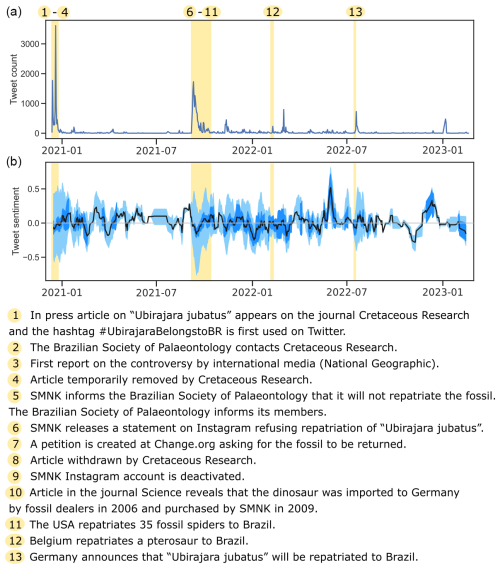
Figure 2Timeline of events during the #UbirajaraBelongstoBR protest. Panel (a) shows the tweet count over time. In panel (b), the black line represents the average sentiment of all tweets containing #UbirajaraBelongstoBR, the shaded dark-blue area represents the average ±1 standard deviation of the tweet sentiment, and the shaded light-blue area shows the 5 % and 95 % percentiles of tweet sentiment on a given day.
The sentiment analysis (Figs. 2b and 3a) reveals that, while a majority of tweets show neutral sentiment, the number of negative tweets is more than 2 times the number of positive tweets. The analysis also shows that most of the tweets related to #UbirajaraBelongstoBR were retweets, i.e. amplified material from other accounts. The overall sentiment is on average neutral, as shown more clearly over time (Fig. 2b).
Our results indicate that, although the overall average sentiment is neutral over the whole timeline of the protest, the points in time when meaningful events did happen, such as when Germany announced in July 2022 that the fossil would be repatriated to Brazil, were moments with more tweets, albeit with a higher standard deviation on the overall sentiment, as shown using blue shaded areas in Fig. 2. These moments of increased standard deviation in sentiment indicate a high number of positive tweets supporting the movement and celebrating small victories, with an equal measure of tweets expressing support not with positivity but, rather, with anger and criticism towards the expropriation of the fossil or towards colonialism in palaeontology.
There are also two moments with peaks of positive sentiment, namely, late May in 2022 and early November in 2022. Despite the high average sentiment, both periods registered a low tweet count – indicating that the high sentiment stemmed from a small number of tweets. In May 2022, the high-sentiment tweets included an “Exciting Announcement! ????” of a palaeo video stream, while in November 2022, they included a sequence of tweets on 3D models of Ubirajara, calling it “one of the most beautiful dinosaurs of Brazil” and giving “shoutouts to helpful souls < 3”. This very positive language (e.g. “exciting”, “beautiful”, “helpful”, and “< 3”) explains the high sentiment scores for that period.
3.2 Social network structure of the protest
The social network of users participating in #UbirajaraBelongstoBR shows that each community involves one user as a leader and some others that follow the leader (Fig. 4). The size of each node indicates the in-degree of each user, i.e. the number of people interacting with them, and the colour of each node indicates the community to which each user belongs, as identified by the Louvain community detection algorithm. We find several well-separated communities of users, which we describe in more detail below.
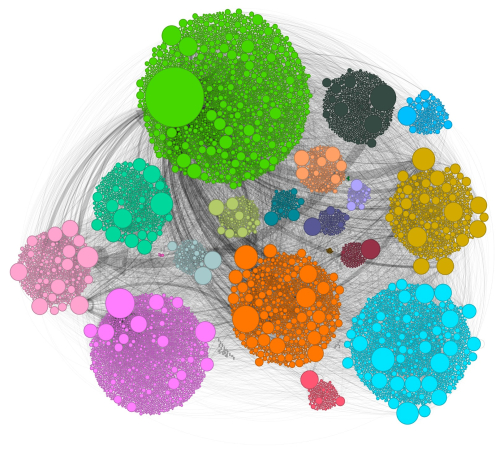
Figure 4Social network of users participating in #UbirajaraBelongstoBR, connected by their shared interactions. Node colours indicate communities in the network.
Comparing the social networks of users (Figs. 4 and 5) reveals that most of the members in each community share the same language. Most people protesting about Ubirajara were Portuguese speakers, as evidenced by 61.76 % of the nodes (shown in pink). There is also a large fraction (32.34 %) of users tweeting in English (shown in blue) and smaller proportions of users tweeting in Spanish, German, and other languages.
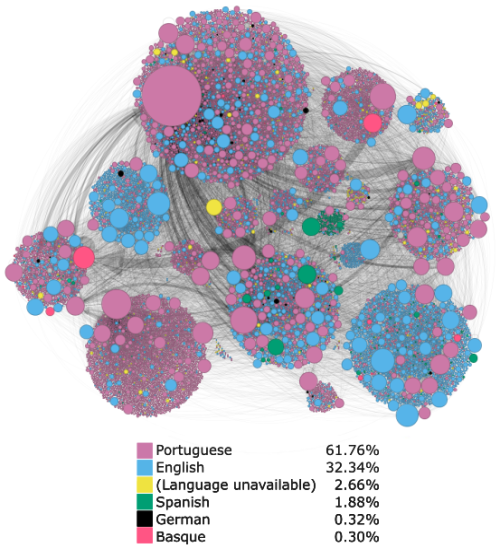
Figure 5Social network of users participating in #UbirajaraBelongstoBR, connected by their shared interactions. Node colours indicate tweet language.
Looking at German in particular, further analysis reveals a total of 170 tweets in German, all of them supporting the hashtag, with 51 tweets adopting a negative tone, 114 adopting a neutral tone, and only 5 tweets adopting a positive tone. Of these 170 aforementioned tweets, we note that 22 are from users self-reporting a location in Brazil, 14 tweets are from users self-reporting a location in Germany, and the remainder (the majority) are from users either in other countries or not reporting any location.
We also assess the most central users of the protest network, as measured by the three centrality metrics defined above, namely, degree centrality, betweenness centrality, and eigenvector centrality. Despite the differences between how each centrality measure is defined, the three measures point at a roughly consistent set of main actors pushing the conversation: @alinemghilardi, a palaeontologist and professor at the Brazilian Federal University of Rio Grande do Norte; @BiodiversidadeB, a Twitter account covering biodiversity content run by João Pedro Salgado; @PaleoCisneros, a palaeontologist and professor at the Brazilian Federal University of Piauí; and @PansyBeast, the account of Julian Francis Miholics, an illustrator who contributed to the protest. The top 5 accounts according to each centrality measure also include @mikannn, corresponding to Miriam Castro, journalist and pop culture influencer; @MMarcosaurus, corresponding to Marcos K. Pinheiro, a geoscience student and artist; and @oTroianoleo, a historian and archaeologist, all of whom supported the protest.
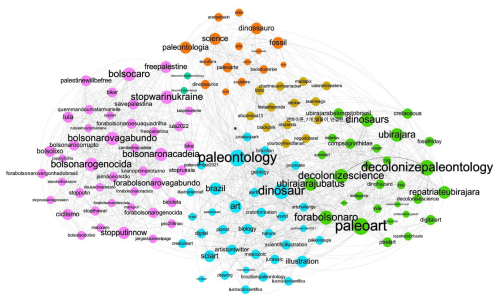
Figure 7A figure with the network of co-occurring hashtags, with node colour indicating different communities of hashtags used in the same tweets.
The high centrality of palaeontologists and biodiversity accounts in the protest network draws into question the actual reach of the movement. This can be assessed by examining the users present in each community (Fig. 6). Figure 6 shows the type of account for the 10 top members of each community that has over 100 members, from Community 1 (with 3064 members) to Community 16 (with 151 members). All of these accounts were examined by the authors and manually categorised into 10 categories of users, based on the information available in each account: palaeontologists, scientists of other disciplines, science journalists, other science communicators, press (e.g. newspapers), other institutions (e.g. museums), artists, politicians, personal accounts, and other, the latter of which includes deleted users, suspended accounts, and Twitter bots. Each community shows a different composition in terms of accounts, as shown by the different colours on the pie charts. While the largest community in the network is made of mostly palaeontologists, the remaining communities have a diverse breakdown of other account types, from scientists and science journalists to artists, politicians, institutional accounts, and many personal user accounts. While it is not possible to examine every account present on the network, this result suggests that the #UbirajaraBelongstoBR did indeed reach beyond the palaeontology bubble and even beyond science and science journalism. The full table of the highest-degree users per community is shown in Appendix B.
The breakdown into communities also allows us to observe how each group of users behaves. While most communities mainly retweet the main tweets with the hashtag, communities 1, 7, 11, and 12 mostly post original tweets. Community 1 includes the main palaeontologists spearheading the movement, with a ratio of original tweets to retweets just over 50/50. Communities 7 and 11 mostly show users tagging other users, with tweets similar to “Hey @you look at this! #UbirajaraBelongsToBR”. In Community 12, however, over 70 % of tweets come from a single user, @bioriderjr, who has since deleted their account. In their tweets, the user messaged Brazilian politicians, science communicators, the German ambassador and German Embassy in Brazil, and Theresia Bauer (who at the time headed the Ministry of Science, Research and Arts for the German state of Baden-Württemberg), demanding the repatriation of the fossil. The full table with the proportions of original tweets versus retweets and quoted tweets is shown in the Appendix (Table B2).
Finally, hashtags such as #paleontology, #decolonizepaleontology, and #paleoart appeared as central and important nodes in the main community (Fig. 7). Those hashtags, shared by the palaeontologists who led the movement, appear to co-occur with several minor hashtags, such as #brazil, #art, or #repatriatubirajara. It is also worth noting that the Ubirajara protest hashtags also appeared alongside other protest hashtags relating to international political events, such as #stopwarinukraine and #freepalestine, and to Brazilian politics, such as #Bolsonarogenocida, #Bolsonarovagabundo, #Bolsocaro, #Forabolsonaro (meaning “genocidal Bolsonaro”, “Bolsonaro bum”, “Bolsonaro expensive”, “Bolsonaro out”, respectively), and #Lula (Lula da Silva, Bolsonaro's main opponent at the time and the current president of Brazil). This spillover of the protest event towards other political topics can be interpreted as an indication of the political inclination of the Twitter users who were concerned about #UbirajaraBelongstoBR.
The #UbirajaraBelongstoBR movement represents a clear example of the intersection of social media activism and the politics of science and academia, particularly within the realm of palaeontology. Our analysis highlights the crucial role of individuals with pre-existing social media influence in amplifying this movement. Such is the case for the palaeontologists, scientists, and science communicators shown in Table 1. This pre-existing presence provided a platform that effectively raised awareness and mobilised public opinion, as evidenced by the widespread sharing and engagement with the hashtag. Notably, the involvement of palaeontologists brought authoritative voices into the public discourse, lending credibility and urgency to the concerns raised about colonial practices in palaeontology. At the same time, the impact of non-palaeontologists, including artists and the general public, demonstrates the movement's reach beyond academic circles, enabling a broader societal engagement.
Our detailed analysis of Twitter data reveals not only the significant role of Portuguese speakers in propelling the discussion but also underscores the contribution of the English-speaking community in a predominantly Portuguese discourse. This bilingual dynamic indicates a broader international concern and engagement with issues of neocolonial practices in science.
We also find that fluctuations in retweeting and sentiment were correlated with important events in the study case. The first fluctuation occurred in the period between the release of the in-press manuscript and its temporary removal by Cretaceous Research 2 weeks later (24 December 2020). The hashtag #UbirajarabelongstoBR was widely mentioned in local media and also appeared on international outlets around this time (Greshko, 2021). The second fluctuation occurred after the announcement by SMNK that the Brazilian dinosaur would not be repatriated (9 September 2021). This is reflected in the negative sentiment of the tweets. The German museum, which lacks a Twitter account, published a statement on Instagram and Facebook declaring the Brazilian fossil to be “property of the State of Baden-Württemberg”, generating great backlash on both platforms. Only 2 weeks after this announcement, the manuscript was permanently withdrawn by Cretaceous Research and it was revealed that the authors of the manuscript provided false information regarding the export of Ubirajara (Pérez Ortega, 2021). Finally, the last fluctuation, reflecting positive tweet sentiment, was connected with the German announcement (15 July 2022) that the dinosaur would be repatriated (Pérez Ortega, 2022).
The Ubirajara case is far from being an isolated one (Cisneros et al., 2022b). The Araripe Basin in Brazil has been a hub of illegally exported fossils for museums and private collectors since the end of the 20th century (Cisneros et al., 2022a). This issue has long been a source of concern for local scientists and authorities and has been echoed by the local press but largely overlooked by both the international scientific community and foreign media. Notable exceptions to this trend were (1) a report by the journal Nature on Brazil's efforts to fight the illegal fossil trade (Gibney, 2014) and (2) a Nature article on the case of the snake-like lizard Tetrapodophis in 2015 (Christakou, 2015). The latter represents, to our knowledge, the first instance of an Araripe fossil study whose legal and ethical circumstances were publicly questioned outside Brazil. This case, however, had only a mild presence on social media and did not achieve the repercussions that Ubirajara had.
As mentioned above, social media activism allows underrepresented voices to attract attention and concentrate discussions around topics that normally would be ignored or misrepresented. The large use of #UbirajaraBelongstoBR on Twitter is a clear example of that, in that it quickly spread and gained attention, collecting efforts from a wide public and forcing the issue to be noticed by stakeholders and news vehicles. This was possible due to both the large social media penetration in Brazil and its potential for use as a science communication tool. Some studies claim that Brazil is now a leader in science communication on social media platforms, with Facebook, Twitter, and YouTube being the main venues (Entradas et al., 2020; Velho and Barata, 2020; Velho et al., 2020). Moreover, the integration of artworks through the hashtag #paleoart, among others, not only enriched the movement's aesthetic but also broadened its appeal and accessibility, allowing for a more diverse demographic engagement. This inclusion of artistic expressions underscores the multidimensional impact of social media movements, bridging science, art, and activism.
This paper also adds more evidence to the cultural value and cultural heritage aspect of fossils. The name “Ubirajara”, meaning “lord of the spear” is derived from the indigenous Brazilian language Tupi, and it is also the title of one of the final novels of Brazilian writer José de Alencar, telling the story of a young warrior of the same name (Alencar, 1874). Treating fossils as cultural heritage may also help the community navigate its protection, as argued in the de Araújo-Júnior et al. (2024).
Historical contexts, such as that of the Araripe Basin and the continuous illegal fossil trade, emphasise the systemic issues within palaeontological research and highlight the need for the stricter enforcement of current regulations and more ethical conduct within the scientific community. Chacon-Baca et al. (2023) highlighted that, even though most journals adhere to the Committee on Publication Ethics (COPE) guidelines, most journals do not require specifications on legal or ethical requirements in their submission guides for authors. The significant media coverage that followed the spread of the hashtag #UbirajaraBelongstoBR illustrates the power of social media in bringing international attention to local issues that have been previously overlooked by global audiences and the scientific community alike. The interconnection of the #UbirajaraBelongstoBR movement with broader political movements against Brazil's far-right government at the time also further contextualises the social and political dimensions of the protest. This alignment suggests that the movement was not only about scientific and ethical issues but also reflected broader societal and political dissent.
As with any study relying on data collected from social media, our analysis has its limitations: although all tweets with #UbirajaraBelongstoBR from the study period were collected, this study does not include related tweets that did not include this specific hashtag. Tweet language inference is also not 100 % accurate, and the anonymity enabled by platforms such as Twitter (now X) means that, even upon close examination, it is not always possible to infer a user's language, location, or field of activity (e.g. if they are palaeontologists or not). Finally, after the recent changes to its data access policy, Twitter (X) is no longer an easily accessible data source for scientific research on social movements – a phenomenon that reflects the current state of research on online platforms (Freelon et al., 2016). This change in policy was followed by the platform being blocked in Brazil from 30 August 2024 to 8 October 2024, which ultimately drove users away from the platform (CBS News, 2024). This further highlights the importance of this study, as an effort to document and archive a social movement that is now obscured by such policies. This is particularly important for a movement like this which was predominantly online, without an equally significant offline component in the form of street protests or anything of the kind.
Still, this study opens potentially fruitful avenues for future research. One potential direction is the examination of the impact of social media on the governance of scientific research and the enforcement of ethical standards, whether for scientific research or not. Another area could involve exploring the role of digital activism in shaping public policy and international agreements on cultural and scientific heritage, such as the policies around illicit fossil trafficking in the case of Ubirajara. Additionally, further studies could investigate the long-term impacts of such movements on public trust in science and on the practices within the palaeontological community.
In conclusion, the #UbirajaraBelongstoBR movement not only challenged neocolonial practices in palaeontology but also showcased the transformative potential of social media as a tool for global awareness and advocacy. This case study serves as a testament to the power of collective action through digital platforms and highlights the evolving landscape of public engagement in scientific discourse.
Table A1Timeline of the #UbirajaraBelongstoBR protest.
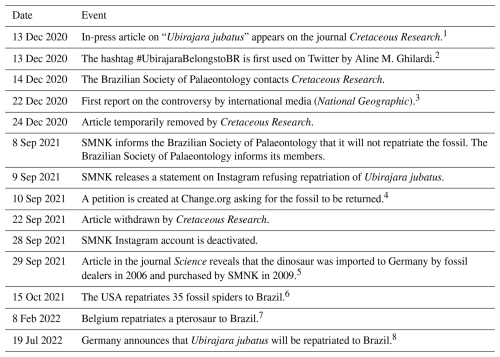
1 The Cretaceous Research article was originally available at https://www.sciencedirect.com/science/article/pii/S0195667120303736 (last access: 30 June 2025). 2 Aline M. Ghilardi's tweet is available at https://twitter.com/alinemghilardi/status/1338199196348919816?s=20&t=Uv9P5IZAXaSwBFXR1GyYWA (last access: 30 June 2025). 3 The National Geographic article is available at https://www.nationalgeographic.com/science/article/one-of-a-kind-dinosaur-removed-from-brazil-sparks-legal-investigation (last access: 30 June 2025). 4 The Change.org petition can be viewed at https://www.change.org/p/ubirajara-belongs-to-brazil (last access: 30 June 2025). 5 The Science article is available at https://www.science.org/content/article/maned-dinosaur-fossil-will-head-back-to-brazil-after-controversy-over-import-to-germany (last access: 30 June 2025). 6 A news article on the repatriation of the fossil spiders is available at https://www.opovo.com.br/noticias/cariri/2021/10/15/traficada-aranha-fossil-que-homenageia-pablo-vittar-retorna-ao-cariri.html (last access: 30 June 2025). 7 A news article on the repatriation of the pterosaur is available at https://g1.globo.com/ce/ceara/noticia/2022/02/02/fossil-de-cranio-de-pterossauro-originario-da-bacia-do-araripe-no-ceara-e-devolvido-ao-brasil-por-museu-da-belgica.ghtml (last access: 30 June 2025). 8 A news article on the German repatriation announcement is available at https://mwk.baden-wuerttemberg.de/de/service/presse/pressemitteilung/pid/land-gibt-dinosaurier-fossil-aus-naturkundemuseum-karlsruhe-an-brasilien-zurueck-1 (last access: 30 June 2025).
Code and data are available at https://doi.org/10.5281/zenodo.15775728 (Camargo, 2025).
CQC coordinated the project and designed the study. MARFK collected the data and carried out the initial analyses; CQC carried out the later analyses. MARFK and CQC produced all figures. NBR was responsible for the literature review and motivation. MARFK wrote the initial material, CQC produced the first draft of the paper, and all authors gave final approval for publication.
The contact author has declared that none of the authors has any competing interests.
The authors confirm that the research received ethical clearance from the University of Exeter's Computer Science department.
Publisher's note: Copernicus Publications remains neutral with regard to jurisdictional claims made in the text, published maps, institutional affiliations, or any other geographical representation in this paper. While Copernicus Publications makes every effort to include appropriate place names, the final responsibility lies with the authors.
The authors would like to thank Aline Ghilardi and Juan Cisneros for multiple conversations and clarifications about #UbirajaraBelongstoBR. Additionally, the authors would like to thank Felipe L. Pinheiro for his support labelling data. Finally, the authors would like to thank everyone who participated in the #UbirajaraBelongstoBR, by drawing, posting, sharing, retweeting, and supporting the movement.
This paper was edited by Lewis Alcott and reviewed by two anonymous referees.
Albuquerque, A. [antoniopedroalb]: “Repatriate me!” – Ubirajara jubatus. A primeira paleoarte digital que eu finalizo tinha que ser ele. #UbirajarabelongstoBR #decolonizepaleontology #DecolonizeScience, Twitter, https://x.com/antoniopedroalb/status/1436053582386696196 (last access: 14 January 2025), 9 September 2021.
Alencar, J. D.: Ubirajara: lenda tupy, Garnier, 1874.
Alli, C. [freakyraptor]: #UbirajarabelongstoBR, Twitter, https://x.com/freakyraptor/status/18868455472839452 (last access: 14 January 2025), 15 December 2020.
Artur [arturvict]: Já passou da hora desses gringos mostrarem algum respeito pelas descobertas dos outros @portsmouthuni @UoPScience @UOP_SEGG #UbirajarabelongstoBR #Decolonizepaleontology, Twitter, https://x.com/arturvict/status/1341762376966823938 (last access: 14 January 2025), 23 December 2020.
Bastian, M., Heymann, S., and Jacomy, M.: Gephi: An Open Source Software for Exploring and Manipulating Networks, Proceedings of the International AAAI Conference on Web and Social Media, 3, 361–362, https://doi.org/10.1609/icwsm.v3i1.13937, 2009.
Bik, E. [MicrobiomDigest]: Hi everyone! I am Elisabeth Bik, PhD, a science integrity consultant and volunteer. In this thread for #YoungScientistNetworking (invited by @QuantumTessera), I will tell a bit about my somewhat unusual career, Twitter, https://twitter.com/MicrobiomDigest (last access: 30 June 2025), 3 April 2024.
Black, R.: Why smuggled fossils are hurting paleontology, Smithsonian Magazine, 10 February 2022, https://www.smithsonianmag.com/science-nature/why-smuggled-fossils-are-hurting-paleontology-180979480/ (last access: 30- June 2025), 2022.
Blondel, V. D., Guillaume, J. L., Lambiotte, R., and Lefebvre, E.: Fast unfolding of communities in large networks, J. Stat. Mech.: Theory Exp., 2008, P10008, https://doi.org/10.1088/1742-5468/2008/10/P10008, 2008.
Caetano, J. M. V., Delcourt, R., and Ponciano, L. C. M. O.: A taxon with no name: `Ubirajara jubatus' (Saurischia: Compsognathidae) is an unavailable name and has no nomenclatural relevance (2023), Zootaxa, 5254, 443–446, https://doi.org/10.11646/zootaxa.5254.3.10, 2023.
Camargo, C.: evoluchico/ubirajarabelongstobr: UbirajaraBelongstoBR paper code and data (v1.0.0), Zenodo [code and data set], https://doi.org/10.5281/zenodo.15775728, 2025.
CBS News: Brazil's Supreme Court lifts ban on social media site X, https://www.cbsnews.com/news/brazil-supreme-court-lifts-ban-social-media-site-x-elon-musk/ (last access: 30 June 2025), 8 October 2024.
Chacon-Baca, E., Moreno, K., Sterli, J., Buldrini, K. E., Chacaltana Budiel, C. A., Echevarría, J., de Araújo Júnior, H. I., Ghilardi, R. P., Tejada-Medina, L. M., and Zurita-Altamirano, D., Perspective on the role of academic journals on scientific colonialism in paleontology, PaleoAmerica, 9, 1–6, 2023.
Christakou, A.: Four-legged snake fossil sparks legal investigation, Nature News, https://doi.org/10.1038/nature.2015.18116, 2015.
Cisneros, J. C., Raja, N. B., Ghilardi, A. M., Dunne, E. M., Pinheiro, F. L., Regalado Fernández, O. R., Sales, M. A. F., Rodríguez-de la Rosa, R. A., Miranda-Martínez, A. Y., González-Mora, S., Bantim, R. A. M., de Lima, F. J., and Pardo, J. D.: Digging deeper into colonial palaeontological practices in modern day Mexico and Brazil, Roy. Soc. Open Sci., 9, 210898, https://doi.org/10.1098/rsos.210898, 2022a.
Cisneros, J. C., Ghilardi, A. M., Raja, N. B., and Stewens, P. P.: The moral and legal imperative to return illegally exported fossils, Nat. Ecol. Evol., 6, 2–3, https://doi.org/10.1038/s41559-021-01588-9, 2022b.
Conover, M. D., Ferrara, E., Menczer, F., and Flammini, A.: The digital evolution of Occupy Wall Street, PLOS ONE, 8, e64679, https://doi.org/10.1371/journal.pone.0064679, 2013a.
Conover, M. D., Davis, C., Ferrara, E., McKelvey, K., Menczer, F., and Flammini, A.: The geospatial characteristics of a social movement communication network, PLOS ONE, 8, e55957, https://doi.org/10.1371/journal.pone.0055957, 2013b.
de Araújo-Júnior, H. I., Ghilardi, R. P., da Silva Caminha, S. A. F., Ribeiro, V. R., de Souza Barbosa, F. H., Scheffler, S. M., and Ribeiro, A. M.: Designation as cultural heritage best protects Brazilian fossils, Nat. Ecol. Evol., 8, 1052–1053, 2024.
Earl, J. and Kimport, K.: Digitally Enabled Social Change: Activism in the Internet Age, MIT Press, online ISBN 9780262295352, print ISBN 9780262015103, https://doi.org/10.7551/mitpress/9780262015103.001.0001, 2011.
Entradas, M., Bauer, M. W., O'Muircheartaigh, C., Marcinkowski, F., Okamura, A., Pellegrini, G., Besley, J., Massarani, L., Russo, P., Dudo, A., Saracino, B., Silva, C., Kano, K., Amorim, L., Bucchi, M., Suerdem, A., Oyama, T., and Li, Y.-Y.: Public communication by research institutes compared across countries and sciences: Building capacity for engagement or competing for visibility?, PLoS ONE, 15, e0235191, https://doi.org/10.1371/journal.pone.0235191, 2020.
Freelon, D., McIlwain, C., and Clark, M.: Quantifying the power and consequences of social media protest, Commun. Res., 20, 990–1011, https://doi.org/10.1177/1461444816676646, 2016.
Ghilardi, A.: Ubirajara belongs to Brazil. #UbirajarabelongstoBR, Twitter, https://x.com/alinemghilardi/status/1338199196348919816 (last access: 14 January 2025), 13 December 2020.
Gibney, E.: Brazil Clamps down on Illegal Fossil Trade, Nature, 507, 1038, https://doi.org/10.1038/507020a, 2014.
Greshko, M.: One-of-a-kind dinosaur removed from Brazil sparks backlash, investigation, National Geographic, 4 January 2021, https://www.nationalgeographic.com/science/article/one-of-a-kind-dinosaur-removed-from-brazil-sparks-legal (lass access: 30 June 2025), 2021.
Herbert, E. [herbertologist]: #UbirajarabelongstoBR, Twitter, https://x.com/herbertologist/status/1338963660266295297 (last access: 14 January 2025), 15 December 2020.
Ince, J., Rojas, F., and Davis, C. A.: The social media response to Black Lives Matter: how Twitter users interact with Black Lives Matter through hashtag use, Ethnic Racial Stud., 40, 1814–1830, 2017.
Jackson, S. J., Bailey, M., and Foucault Welles, B.: #HashtagActivism: Networks of race and gender justice, MIT Press, ISBN 9780262356503, https://doi.org/10.7551/mitpress/10858.001.0001, 2020.
Kauane, B. [brenda7kauane]: Ubirajara jubatus is a dinosaur discovered in Brazil, but it's in Germany and appears in articles by a paleontologist named David Matill normally involved in fossil handling. Help us tu repatriate, Twitter, https://x.com/Brenda7kauane/status/1439789876447166466 (last access: 14 January 2025), 8 March 2021.
Kumar, S., Jailani, N. A., Singh, A. R., and Panchal, S.: Sentiment Analysis on Online Reviews using Machine Learning and NLTK, in: IEEE 2022 6th International Conference on Trends in Electronics and Informatics (ICOEI), Tirunelveli, India, 1183–1189, https://doi.org/10.1109/ICOEI53556.2022.9776850, 2022.
Mingau [_themingau]: Ubirajara is an incredible animal, but as a Brazilian, I'm sad. I chose to do it with the colors of the Brazilian flag. #UbirajarabelongstoBRhttps://x.com/_themingau/status/1338358886034714624/ photo/1, Twitter, https://x.com/_themingau/status/1338358886034714624 (last access: 14 January 2025), 14 December 2020.
Monarrez, P. M., Zimmt, J. B., Clement, A. M., Gearty, W., Jacisin, J. J., Jenkins, K. M., Kusnerik, K. M., Poust, A. W., Robson, S. V., Sclafani, J. A., Stilson, K. T., Tennakoon, S. D., and Thompson, C. M.: Our past creates our present: a brief overview of racism and colonialism in Western paleontology, Paleobiology, 48, 173–185, https://doi.org/10.1017/pab.2021.28, 2021.
Ocon, S. B., Lundgren, L., Bex II, R. T., Bauer, J. E., Hughes, M. J., and Mills, S. M.: Follow the Fossils: Developing Metrics for Instagram as a Natural Science Communication Tool, in: 1st Edn., Cambridge University Press, https://doi.org/10.1017/9781009157476, 2021.
Paleonecromante [THSpike]: This is Ubirajara jubatus and he wants to turn to his home … #UbirajarabelongstoBR #paleontologia #paleontologia #paleoarte #paleoart #sciart #escultura #escultura #dinossauro #dinossauro #BaciaDoAraripe #AraripeBasin #fossil, Twitter, https://x.com/THSpike/status/1340711872169979907 (last access: 14 January 2025), 20 December 2020.
Pérez Ortega, R.: Retraction is `second extinction' for rare dinosaur, Science, 374, 14–15, https://doi.org/10.1126/science.acx9215, 2021.
Pérez Ortega, R.: Rare dinosaur heads home as Germany agrees to return Brazilian fossil, Science, https://doi.org/10.1126/science.ade0219, in press, 2022.
Raja, N. B. and Dunne, E. M.: Fossil Trafficking, Fraud, and Fakery, in: Art Crime in Context, vol. 6, edited by: Oosterman, N. and Yates, D., Springer International Publishing, Cham, 61–79, https://doi.org/10.1007/978-3-031-14084-6_5, 2023.
Raja, N. B., Dunne, E. M., Matiwane, A., Khan, T. M., Nätscher, P. S., Ghilardi, A. M., and Chattopadhyay, D.: Colonial history and global economics distort our understanding of deep-time biodiversity, Nat. Ecol. Evol., 6, 145–154, https://doi.org/10.1038/s41559-021-01608-8, 2022.
Roesslein, J.: Tweepy: A Python library for accessing the Twitter API, GitHub [code], https://github.com/tweepy/tweepy (last access: 30 June 2025), 2009.
Shen, H.: Meet this super-spotter of duplicated images in science papers, Nature, 581, 132–136, https://doi.org/10.1038/d41586-020-01363-z, 2020.
Stepp, E. [Emily_Art]: Brazilian Spear and Fang want to go home. Dinocember day 19 “Irritator Primal Style” with a bonus Ubirajara, Twitter, https://x.com/Emily_Art/status/1340461658901106688 (last access: 14 January 2025), 20 December 2020.
valent801 [valent801]: My modest contribution to the #UbirajarabelongstoBR, let's hope this story will ends well for this little dino fossil. Drawing reference from the scientific paper “science direct” of the Ubirajara, Twitter, https://x.com/valent801/status/1338876663514472451 (last access: 14 January 2025), 15 December 2020.
Velho, R. M. and Barata, G.: Profiles, Challenges, and Motivations of Science YouTubers, Front. Commun., 5, 542936, https://doi.org/10.3389/fcomm.2020.542936, 2020.
Velho, R. M., Mendes, A. M. F., and Azevedo, C. L. N.: Communicating Science With YouTube Videos: How Nine Factors Relate to and Affect Video Views, Front. Commun., 5, 567606, https://doi.org/10.3389/fcomm.2020.567606, 2020.
Walter, S., Lörcher, I., and Brüggemann, M.: Scientific networks on Twitter: Analyzing scientists' interactions in the climate change debate, Publ. Underst. Sci., 28, 696–712, https://doi.org/10.1177/0963662519844131, 2019.
Waxosaurus Makes [Waxosaurus]: Tonight is a very late one, had to repost it due to issues. Day 16 of Dinocember, Ubirajara in two styles. Coprolite post style and the usual wax style. #UbirajarabelongstoBR, Twitter, https://x.com/Waxosaurus/status/1339387957015359491 (last access: 14 January 2025), 17 December 2020.
Yammine, S. Z., Liu, C., Jarreau, P. B., and Coe, I. R.: Social media for social change in science, Science, 360, 162–163, https://doi.org/10.1126/science.aat7303, 2018.
The name “Ubirajara jubatus” was removed from ZooBank in November 2022, which means that it no longer has any nomenclatural significance (Caetano et al., 2023). In this paper, we will refer to it as “Ubirajara”.
- Abstract
- Introduction
- Materials and methods
- Results
- Discussion and conclusion
- Appendix A: Full timetable of events
- Appendix B: Users with highest degree in all communities
- Code and data availability
- Author contributions
- Competing interests
- Ethical statement
- Disclaimer
- Acknowledgements
- Review statement
- References
- Abstract
- Introduction
- Materials and methods
- Results
- Discussion and conclusion
- Appendix A: Full timetable of events
- Appendix B: Users with highest degree in all communities
- Code and data availability
- Author contributions
- Competing interests
- Ethical statement
- Disclaimer
- Acknowledgements
- Review statement
- References






